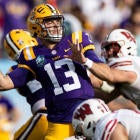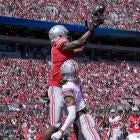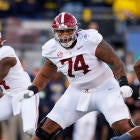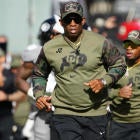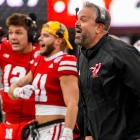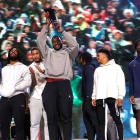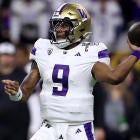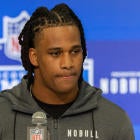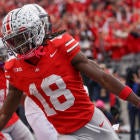It's time for my annual ranking of national champions in the College Football Playoff and BCS eras.
Where does Clemson rank among the 19 champions crowned since a national championship game was installed? There are no right or wrong answers. The only intended purpose is to do what college football fans love the most -- debate.
19. 2007 LSU (12-2)
Average margin of victory: 21.8 points
Record of FBS opponents: 103-75 (.579)
Wins vs. teams in final AP Top 25: 5 (No. 5 Ohio State, No. 9 Virginia Tech, No. 12 Tennessee, No. 13 Florida, No. 15 Auburn)
Offensive stats: 38.6 points/game (11th nationally), 5.84 yards/play (28th)
Defensive stats: 19.9 points/game (17th), 4.42 yards/play (T4)
Bottom line: No. 19 on this list was easily 2007 LSU. The Tigers handled Ohio State in the BCS Championship Game. But they only got there thanks to a handful of final-day losses that jumped LSU from No. 7 to No. 2 in the last BCS standings. LSU lost to two eight-win teams, Kentucky and Arkansas, and remains the only champion with two losses since a championship game was established in 1998.
18. 2006 Florida (13-1)
Average margin of victory: 17.5 points
Record of FBS opponents: 108-61 (.639)
Wins vs. teams in final AP Top 25: 5 (No. 2 Ohio State, No. 3 LSU, No. 15 Arkansas, No. 23 Georgia, No. 25 Tennessee)
Offensive stats: 29.7 points/game (23rd), 6.34 yards/play (12th)
Defensive stats: 13.5 points/game (6th), 4.32 yards/play (T6)
Bottom line: Meyer's first of three national champions was his weakest. These defensive-minded Gators barely snuck into the BCS Championship Game and proved their worth by routing Ohio State. Florida's 2006 season was all about survival through a brutal schedule that included a loss at 11-win Auburn.
17. 2000 Oklahoma (13-0)
Average margin of victory: 22.1 points
Record of FBS opponents: 87-70 (.554)
Wins vs. teams in final AP Top 25: 5 (No. 5 Florida State, No. 8 Nebraska, No. 9 Kansas State twice, No. 12 Texas)
Offensive stats: 39.0 points/game (7th), 5.99 yards/play (12th)
Defensive stats: 16.0 points/game (7th), 4.14 yards/play (7th)
Bottom line: The Sooners might rank higher if not for a boring 13-2 championship game victory over Florida State, which was a controversial BCS pick over Miami. Over three consecutive weeks in October, Oklahoma defeated then-No. 11 Texas, then-No. 2 Kansas State and then-No. 1 Nebraska, and later beat Kansas State again in the Big 12 Championship Game.
16. 1998 Tennessee (13-0)
Average margin of victory: 18.6 points
Record of FBS opponents: 82-71 (.536)
Wins vs. teams in final AP Top 25: 5 (No. 3 Florida State, No. 5 Florida, No. 14 Georgia, No. 16 Arkansas, No. 25 Syracuse)
Offensive stats: 34.0 points/game (17th), 6.04 yards/play (23rd)
Defensive stats: 14.4 points/game (9th), 4.40 yards/play (14th)
Bottom line: Who needed Peyton Manning? With Manning gone and Tee Martin at quarterback, these Volunteers mashed opponents upfront on offense and defense -- and had a little luck against Arkansas along the way with Clint Stoerner's generous fumble. Tennessee won two games on the road. This may be low for an undefeated SEC champion, but the SEC in 1998 wasn't the SEC in 2008.
15. 2003 LSU (13-1)
Average margin of victory: 22.9 points
Record of FBS opponents: 88-79 (.527)
Wins vs. teams in final AP Top 25: 5 (No. 3 Oklahoma, No. 7 Georgia twice, No. 13 Ole Miss, No. 24 Florida)
Offensive stats: 33.9 points/game (19th), 5.89 yards/play (T28)
Defensive stats: 11.0 points/game (1st), 4.02 yards/play (1st)
Bottom line: Saban's first national championship team suffered its only loss to eight-win Florida. LSU beat Oklahoma by a touchdown in the BCS Championship Game. Too bad the Tigers and USC, the AP national champion that season, never got to play. The split title figures to always impact how LSU 2003 gets remembered despite its very strong defense.
14. 2002 Ohio State (14-0)
Average margin of victory: 16.2 points
Record of FBS opponents: 100-81 (.552)
Wins vs. teams in final AP Top 25: 4 (No. 2 Miami, No. 9 Michigan, No. 10 Washington State, No. 16 Penn State)
Offensive stats: 29.3 points/game (41st), 5.61 yards/play (T26)
Defensive stats: 13.1 points/game (2nd), 4.66 yards/play (24th)
Bottom line: Thanks to a controversial pass interference call, Ohio State stunned a talented Miami team in overtime to win the national title. The Buckeyes won half their games by a touchdown or less, using a conservative offense with Maurice Clarett and relying on a strong and very talented defense. The Buckeyes' national rankings on offense and defense prevent them from being higher despite going undefeated.
13. 2015 Alabama (14-1)
Average margin of victory: 19.9 points
Record of FBS opponents: 125-60 (.676)
Wins vs. teams in final AP Top 25: 6 (No. 2 Clemson, No. 6 Michigan State, No. 16 LSU, No. 21 Wisconsin, No. 22 Tennessee, No. 25 Florida)
Offensive stats: 35.1 points/game (30th), 5.89 yards/play (49th)
Defensive stats: 15.1 points/game (T-2nd), 4.30 yards/play (2nd)
Bottom line: Alabama proved its dynasty wasn't over by rebounding from a loss to eventual 10-win Ole Miss. If not for Arkansas' crazy fourth-and-25 conversion against Ole Miss, the Crimson Tide wouldn't have played for the SEC championship. The winning percentage for Alabama's FBS opponents was easily the best by a national champion in the BCS and CFP eras. But I think most agree this was Saban's weakest national champion at Alabama.
12. 2016 Clemson (14-1)
Average margin of victory: 21.2 points
Record of FBS opponents: 120-64 (.652)
Wins vs. teams in final AP Top 25: 6 (No. 24 Auburn, No. 21 Louisville, No. 8 Florida State, No. 16 Virginia Tech, No. 6 Ohio State, No. 2 Alabama)
Offensive stats: 39.2 points/game (14th), 6.19 yards per play (34th)
Defensive stats: 18.0 points per game (10th), 4.63 yards per play (5th)
Bottom line: Clemson 2016 gets the slight nod over Alabama 2015 by virtue of not needing an onside kick to save the game. Deshaun Watson knocking off Alabama will forever be part of national championship lore, similar to Vince Young beating USC. Early in the season, the Tigers struggled some against inferior opponents but they got hot late and won the best conference in 2016. The future NFL talent on this team may include Watson, Dexter Lawrence, Mike Williams and Christian Wilkins, among others. History will likely remember this team fondly because of Watson and the thrilling championship game. It will be interesting to see if Dabo Swinney produces even more talented teams in the future. Clemson is positioned to stay elite.
11. 2012 Alabama (13-1)
Average margin of victory: 27.8 points
Record of FBS opponents: 95-70 (.576)
Wins vs. teams in final AP Top 25: 4 (No. 4 Notre Dame, No. 5 Georgia, No. 14 LSU, No. 24 Michigan)
Offensive stats: 38.7 points/game (12th), 6.95 yards/play (5th)
Defensive stats: 10.9 points/game (1st), 4.18 yards/play (2nd)
Bottom line: Despite Saban fielding his least-experienced national championship team, Alabama again led the nation in defense, though it allowed at least 28 points against two of the three top-20 offenses it played. The offense, led by a dominant offensive line to assist AJ McCarron, Eddie Lacy, T.J. Yeldon, and Amari Cooper, was statistically Alabama's best among its four championship teams under Saban.
10. 2014 Ohio State (14-1)
Average margin of victory: 22.8 points
Record of FBS opponents: 118-77 (.605)
Wins vs. teams in final AP Top 25: 4 (No. 2 Oregon, No. 4 Alabama, No. 5 Michigan State, No. 13 Wisconsin)
Offensive stats: 44.8 points/game (5th), 6.98 yards/play (6th)
Defensive stats: 22.0 points/game (26th), 4.98 yards/play (25th)
Bottom line: In the first year of the CFP, Ohio State proved as the No. 4 seed it's possible to overcome a bad home loss early (Virginia Tech) by continuing to improve. The Buckeyes ended the season with Ezekiel Elliott running wild, third-string quarterback Cardale Jones throwing bombs, and an improved defense holding in check offenses that had the top three Heisman Trophy finalists (Wisconsin, Alabama and Oregon).
9. 2010 Auburn (14-0)
Average margin of victory: 17.1 points
Record of FBS opponents: 92-62 (.597)
Wins vs. teams in final AP Top 25: 7 (No. 3 Oregon, No. 8 LSU, No. 10 Alabama, No. 12 Arkansas, No. 15 Mississippi State, No. 22 South Carolina twice)
Offensive stats: 41.2 points/game (7th), 7.37 yards/play (3rd)
Defensive stats: 24.1 points/game (53rd), 5.36 yards/play (56th)
Bottom line: Cam Newton, under a cloud of NCAA suspicion before later being cleared, produced college football's most remarkable individual season in ages. The Tigers had eight second-half comebacks, including a memorable rally at Alabama. Auburn's defensive stats are the worst by a BCS or CFP champion, but Nick Fairley and company always rose to the occasion and shut down Oregon's high-scoring offense. This team consistently remains the toughest one for me to rank.
8. 1999 Florida State (12-0)
Average margin of victory: 21.3 points
Record of FBS opponents: 82-67 (.550)
Wins vs. teams in final AP Top 25: 4 (No. 2 Virginia Tech, No. 12 Florida, No. 15 Miami, No. 20 Georgia Tech)
Offensive stats: 37.5 points/game (4th), 5.71 yards/play (12th)
Defensive stats: 15.8 points/game (10th), 4.49 yards/play (13th)
Bottom line: Chris Weinke throwing to Peter Warrick was a wildly successful passing combination for Florida State. The Seminoles got a scare for a while in the title game against Michael Vick and Virginia Tech before winning Bobby Bowden's second national championship. Virginia Tech was the only team Florida State played that finished in the top 10 of the final AP Top 25. The Seminoles' defense had future NFL starters Corey Simon, Tay Cody, Derrick Gibson, Mario Edwards, and kicker Sebastian Janikowski continues to play in the NFL.
7. 2009 Alabama (14-0)
Average margin of victory: 20.4 points
Record of FBS opponents: 101-67 (.601)
Wins vs. teams in final AP Top 25: 5 (No. 2 Texas, No. 3 Florida, No. 10 Virginia Tech, No. 17 LSU, No. 20 Ole Miss)
Offensive stats: 32.1 points/game (22nd), 5.96 yards/play (T32)
Defensive stats: 11.7 points/game (2nd), 4.08 yards/play (4th)
Bottom line: This was Saban's first championship team at Alabama and the one that essentially ended the Meyer's run with the Gators by destroying them in the SEC Championship Game. There was a close call along the way: Terrence Cody blocked a field goal to preserve a win over pedestrian Tennessee in Lane Kiffin's only year in Knoxville. Mark Ingram, Trent Richardson, Marcell Dareus, Rolando McClain, Javier Arenas, Julio Jones, Mark Barron and Dont'a Hightower were among the contributors who reached the NFL, where they have had mixed careers.
6. 2011 Alabama (12-1)
Average margin of victory: 26.7 points
Record of FBS opponents: 91-63 (.591)
Wins vs. teams in final AP Top 25: 2 (No. 2 LSU, No. 5 Arkansas)
Offensive stats: 34.9 points/game (20th), 6.46 yards/play (12th)
Defensive stats: 8.2 points/game (1st), 3.32 yards/play (1st)
Bottom line: The Crimson Tide won the nation -- but not the SEC -- thanks to a dominating rematch victory over LSU, which entered with as good a No. 1 resume in some time. Forty-five Alabama and LSU players from those games were drafted by the NFL, including 16 of the 22 defensive starters. Alabama became the first defense to lead the nation in scoring, rushing, passing and total yards since Oklahoma in 1986. However, Alabama played only one FBS opponent whose offense ranked higher than 86th in total yards (No. 29 Arkansas). I've talked to a couple Alabama players who were on the 2009 and 2011 teams. They believe 2011 was Saban's best championship team.
5. 2008 Florida (13-1)
Average margin of victory: 33.1 points
Record of FBS opponents: 100-58 (.633)
Wins vs. teams in final AP Top 25: 4 (No. 5 Oklahoma, No. 6 Alabama, No. 13 Georgia, No. 21 Florida State)
Offensive stats: 43.6 points/game (4th), 7.13 yards/play (3rd)
Defensive stats: 12.9 points/game (4th), 4.46 yards/play (10th)
Bottom line: Yes, the Gators lost (by one point to nine-win Ole Miss). But Florida blew out opponents, pulled out tight wins and contained Oklahoma's record-setting offense in the title game. The talent was through the roof: Percy Harvin, Carlos Dunlap, Janoris Jenkins, Mike Pouncey, Maurkice Pouncey, Louis Murphy, Joe Haden, Aaron Hernandez, Brandon Spikes and Tim Tebow, among others. This team was so talented that some quarterback named Cam Newton barely played for the Gators.
4. 2013 Florida State (14-0)
Average margin of victory: 39.5 points
Record of FBS opponents: 82-72 (.532)
Wins vs. teams in final AP Top 25: 3 (No. 2 Auburn, No. 8 Clemson, No. 23 Duke)
Offensive stats: 51.6 points/game (2nd), 7.67 yards/play (1st)
Defensive stats: 12.1 points/game (1st), 4.09 yards/play (2nd)
Bottom line: Against a fairly weak schedule, the Seminoles blew out almost everyone and finished with the largest margin of victory and most points per game by any BCS or CFP champion. In the title game against Auburn, Florida State proved it could overcome adversity by rallying from a 21-3 deficit and winning on a last-second touchdown. Twenty players have been drafted from these Seminoles, including nine in the first two rounds. Many of them are NFL starters. Jameis Winston's backup quarterback, Jake Coker, won a national title for Alabama.
3. 2005 Texas (13-0)
Average margin of victory: 35.3 points
Record of FBS opponents: 88-66 (.571)
Wins vs. teams in final AP Top 25: 4 (No. 2 USC, No. 4 Ohio State, No. 20 Texas Tech, No. 22 Oklahoma)
Offensive stats: 50.2 points/game (1st), 7.07 yards/play (2nd)
Defensive stats: 16.4 points/game (8th), 4.39 yards/play (9th)
Bottom line: Texas produced seven games with 50 points or more and outlasted extremely talented USC, thanks to Vince Young, in a memorable national championship game. The defense wasn't too bad, either. Jamaal Charles, Michael Griffin, Michael Huff, Brian Orakpo and Aaron Ross are among the contributors who carved out productive NFL careers. Just as impressively, the Longhorns went to Columbus early in the season and defeated Ohio State. Texas' scoring average on offense is the second-highest by a champion in the BCS/CFP eras.
2. 2004 USC (13-0)
Average margin of victory: 25.2 points
Record of FBS opponents: 82-70 (.539)
Wins vs. teams in final AP Top 25: 4 (No. 3 Oklahoma, No. 9 California, No. 10 Virginia Tech, No. 19 Arizona State)
Offensive stats: 38.2 points/game (6th), 6.33 yards/play (T6)
Defensive stats: 13.0 points/game (3rd), 4.27 yards/play (T5)
Bottom line: The Trojans had two eventual Heisman Trophy winners in their backfield (Matt Leinart and Reggie Bush) and a dominating defense. USC's Pac-10 schedule wasn't overwhelming, but the Trojans went across the country to beat 10-win Virginia Tech in Washington, D.C., and crushed Oklahoma 55-19 for back-to-back national titles (if you're counting the 2003 AP title). The Trojans had 31 NFL Draft picks (including eight first-rounders), and players such as Lofa Tatupu, Ryan Kalil, Sam Baker, LenDale White and Bush had productive NFL careers. USC had to vacate the 2004 championships due to NCAA violations involving Bush, who was stripped of his Heisman. Sorry, the games happened. We're still counting this team, which would be No. 1 if not for ...
1. 2001 Miami (12-0)
Average margin of victory: 32.9 points
Record of FBS opponents: 81-60 (.574)
Wins vs. teams in final AP Top 25: 6 (No. 8 Nebraska, No. 14 Syracuse, No. 15 Florida State, No. 18 Virginia Tech, No. 19 Washington, No. 21 Boston College)
Offensive stats: 43.2 points/game (3rd), 6.57 yards/play (6th)
Defensive stats: 9.4 points/game (1st), 3.93 yards/play (4th)
Bottom line: This team produced an absurd 38 NFL Draft picks, including 17 taken in the first round. The '01 Hurricanes were a Who's Who of future NFL players: Clinton Portis, Andre Johnson, Frank Gore, Bryant McKinnie, Sean Taylor, Ed Reed, Antrel Rolle, Jeremy Shockey, Jonathan Vilma, D.J. Williams, Vince Wilfork, Roscoe Parrish, Willis McGahee, and Kellen Winslow Jr., to name a few. Miami led overmatched Nebraska 34-0 at halftime of the 2002 Rose Bowl.
It's a shame that Miami, USC and Alabama never played each other during their peak. But that's how championship cycles work. Since college football added a national championship game, the 2001 Hurricanes remain the standard bearer for champions in the BCS/CFP era.













